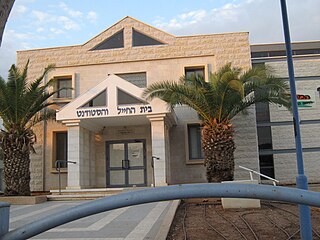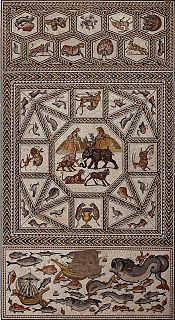 W
WBeit She'an, also known as Beisan, and historically known as Scythopolis is a city in the Northern District of Israel, which has played an important role in history due to its geographical location at the junction of the Jordan River Valley and the Jezreel Valley.
 W
WThe Church of the Multiplication of the Loaves and Fish, shortened to the Church of the Multiplication, is a Roman Catholic church located at Tabgha, on the northwest shore of the Sea of Galilee in Israel. The modern church rests on the site of two earlier churches.
 W
WEin Gedi, also spelt En Gedi, meaning "spring of the kid", is an oasis and a nature reserve in Israel, located west of the Dead Sea, near Masada and the Qumran Caves. Ein Gedi was listed in 2016 as one of the most popular nature sites in the country. The site attracts about one million visitors a year.
 W
WHamat Gader is a hot springs site in the Yarmouk River valley, used since the classical antiquity. It is located in an area under Israeli control, in what was a demilitarized zone between Israel and Syria from 1949 to 1967. The site is next to the Jordanian border, and about 10 kilometres (6.2 mi) from the tripoint of Israel, Jordan and Syria. It is set on several mineral springs with temperatures up to 50 °C.
 W
WHammath Tiberias or Hammat Tiberias is an ancient archaeological site and an Israeli national park known as Hamat Tverya National Park, which is located on the adjacent to Tiberias on the road to Zemach that runs along the shore of the Sea of Galilee.
 W
WHuqoq or Hukkok was an ancient Jewish village, located 12.5 km north of Tiberias. The area had been settled since ancient times and is mentioned in the Book of Joshua. The Palestinian village Yaquq was built at Huqoq's location, and a kibbutz named Hukok was established near the site on 11 July 1945.
 W
WThe Lod Mosaic is a mosaic floor dated to ca. 300 CE discovered in 1996 in the Israeli town of Lod, formerly Lydda. Believed to have been created for a private villa, it is one of the largest and best-preserved mosaic floors uncovered in the country. It depicts land animals, fish and two Roman ships. It was restored in the labs of the Israel Antiquities Authority (IAA). After an overseas tour of several years it will be displayed in the purpose-built Shelby White and Leon Levy Lod Mosaic Archaeological Center.
 W
WThe Maon Synagogue is a 6th-century synagogue and archaeological site located in the Negev Desert near Kibbutz Nirim and Kibbutz Nir Oz. It is noted for its "magnificent" mosaic floor.
 W
WThe Mosaic of Reḥob, also known as the Tel Rehov inscription and Baraita of the Boundaries, is a late 3rd–6th century CE mosaic discovered in 1973, inlaid in the floor of the foyer or narthex of an ancient synagogue near Tel Rehov, 4.5 kilometers (2.8 mi) south of Beit She'an and about 6.5 kilometres (4.0 mi) west of the Jordan River, containing the longest written text hitherto discovered in any mosaic in the Land of Israel, and also the oldest known Talmudic text.
 W
WNaaran is an ancient Jewish village dating to the 5th and 6th century CE, located in the West Bank. Remains of the village have been excavated north of Jericho, in Ephraim, between Bethel and Jericho. The mosaic floor of a synagogue was discovered at the site featuring a large zodiac design. Naaran is mentioned in Joshua 16:7 and 1 Chronicles 7:28 as a town in the eastern part of Ephraim. Eusebius, in his Onomasticon, makes mention of the site, saying that in his day it was "a village inhabited by Jews, five [Roman] miles from Jericho." The site is also named in the writings of Josephus, under its name, and in the Midrash Rabba. Aramaic inscriptions and mosaics from the synagogue are displayed at an archaeology museum established by the Israeli archaeologist Yitzhak Magen at the Good Samaritan Inn.
 W
WSepphoris or Zippori in the past called Diocaesaraea and, during the Crusades, le Saforie, is a former village and an archaeological site located in the central Galilee region of Israel, 6 kilometers north-northwest of Nazareth. It lies 286 meters above sea level and overlooks the Beit Netofa Valley. The site holds a rich and diverse historical and architectural legacy that includes Hellenistic, ancient Jewish, Roman, Byzantine, Islamic, Crusader, Arab and Ottoman remains. In Mandatory Palestine it was a town known as Saffuriya, with a population of approximately 5,000 people, until its depopulation in 1948.
 W
WTzippori Synagogue is an ancient synagogue discovered in Sepphoris, a Roman-era Jewish city in the Galilee, now an archaeological site and a national park in Israel.